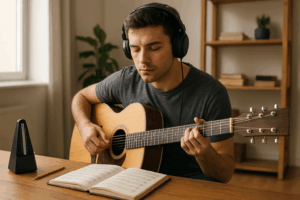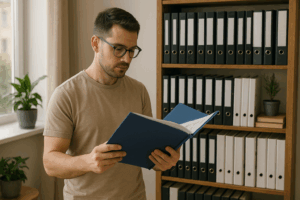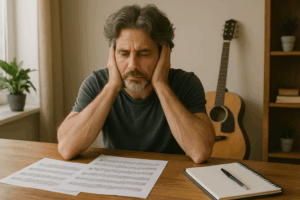Creating a dedicated music practice space at home can significantly enhance your musical progress. Whether you’re learning an instrument or working on improving your technique, having a quiet, organized, and inspiring environment can make your practice sessions more effective and enjoyable. In this article, we’ll explore how to set up a music practice space that supports your learning and creativity, no matter the size of your home or the instrument you play.
1. Choose the Right Location
The first step in setting up your practice space is selecting the right location. Ideally, your music practice area should be somewhere quiet and free from distractions. This allows you to focus entirely on your music without interruptions.
Considerations for Choosing the Right Space:
- Quiet Room: Find a room in your home that is away from high-traffic areas and noise. A basement, spare room, or corner of your living room might work well. If you don’t have a dedicated room, you can create a makeshift practice corner.
- Acoustic Considerations: If you’re practicing an instrument like a piano or guitar, consider the acoustics of the room. Rooms with too much echo or noise can make it hard to hear yourself clearly. You can mitigate sound issues with carpets, curtains, or even soundproofing foam.
- Space for Movement: If you’re practicing dance, drumming, or other physically demanding instruments, make sure there is enough room for you to move comfortably.
Choosing a quiet and comfortable space will help you stay focused and motivated during your practice sessions.
2. Invest in the Right Equipment
Having the proper equipment can enhance your practice experience and help you make the most of your time. The right tools will depend on the instrument you play, but there are some essentials that every musician needs.
Essential Items for Your Practice Space:
- Instrument Setup: Ensure that your instrument is in good condition and ready to use. This might include tuning your guitar, cleaning your piano keys, or setting up your drum kit properly. Having your instrument well-maintained is crucial for smooth practice.
- Music Stand: A music stand helps you keep sheet music, books, or notes in front of you while practicing. It helps you stay organized and ensures proper posture while reading music.
- Recording Equipment: If you want to track your progress or record your practice sessions, consider investing in basic recording equipment, such as a microphone or digital recorder. This allows you to listen to yourself and identify areas for improvement.
- Metronome: A metronome is essential for keeping time and improving your rhythm. There are many metronome apps or physical devices available that you can use to stay on beat during your practice.
- Comfortable Seating: A comfortable chair or stool is important for long practice sessions. Ensure that you have an ergonomic seat that supports proper posture, especially if you’re playing an instrument like the piano or guitar.
Having the right equipment will ensure that your practice sessions are productive and comfortable, making it easier to focus on improving your skills.
3. Organize Your Space for Maximum Efficiency
An organized practice space can help reduce distractions and make it easier to access everything you need during your sessions. Clutter can hinder your focus, so it’s important to keep your space neat and tidy.
Tips for Organizing Your Practice Area:
- Storage Solutions: Invest in storage solutions such as shelves, bins, or drawers to keep your music books, sheet music, accessories, and other equipment organized. Having a designated place for everything ensures that you can easily find what you need during practice.
- Keep Your Space Clear: Keep your practice space free from unnecessary distractions. This could mean putting away your phone, turning off the TV, or removing items that might draw your attention away from your music.
- Cable Management: If you use electronic equipment such as amplifiers, microphones, or MIDI controllers, make sure to manage cables to avoid tangling and clutter. Use cable organizers or ties to keep everything in place.
An organized space allows you to focus on your music rather than spending time looking for things or dealing with distractions.
4. Create an Inspiring Environment
Your practice space should be a place where you feel motivated and inspired to improve. Adding personal touches and creating a positive atmosphere can help you stay focused and make your practice sessions more enjoyable.
How to Create an Inspiring Space:
- Decorate with Purpose: Add artwork, motivational quotes, or pictures of your musical idols to inspire you. Surrounding yourself with visuals that motivate you can help create a positive mindset for practice.
- Good Lighting: Adequate lighting is essential for reading music and avoiding eye strain. Natural light is best, but if that’s not possible, make sure your practice area is well-lit with adjustable lamps that provide ample light without creating harsh shadows.
- Comfortable Ambiance: If you enjoy music-related memorabilia or items that help set the mood, feel free to incorporate them into your space. Whether it’s a cozy rug, a comfortable chair, or a soothing color palette, your practice space should feel like a place where you enjoy spending time.
A space that is visually stimulating and comfortable will encourage you to spend more time practicing and will help keep you motivated.
5. Minimize Distractions and Set Boundaries
If you practice in a shared space or a busy household, it can be challenging to minimize distractions. Establishing boundaries and communicating your practice schedule with others can help ensure you have uninterrupted time to focus on your music.
How to Minimize Distractions:
- Set Practice Hours: Establish a regular practice schedule and communicate it with your family, roommates, or anyone else in your household. This way, they know when you need quiet time to practice.
- Use Noise-Cancelling Headphones: If noise from your surroundings is unavoidable, noise-cancelling headphones can help you focus. They are especially useful for practicing with backing tracks or for those who live in noisy environments.
- Turn Off Notifications: Put your phone on silent or turn off notifications to avoid being distracted during your practice session. This will allow you to stay fully immersed in your music.
By minimizing distractions, you can make the most of your practice time and focus on improving your musical skills.
6. Incorporate Comfort and Functionality
Your practice space should not only be organized and inspiring but also comfortable and functional. Spend long hours in your practice area, so it’s important to have the right setup to keep you comfortable and avoid physical strain.
Comfort and Functionality Tips:
- Proper Seating: As mentioned, seating plays a significant role in your comfort. Make sure you have a comfortable chair or stool that supports good posture, especially for instruments that require long sessions of sitting.
- Adequate Footrest: If you’re playing piano or another seated instrument, a footrest can improve posture and provide better control.
- Temperature Control: Make sure your practice space is well-ventilated and at a comfortable temperature to avoid feeling sluggish or distracted by environmental factors.
Ensuring your space is comfortable will help you focus on playing rather than dealing with physical discomfort.



